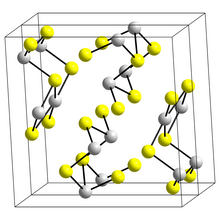
Back Trisulfur de diantimoni Catalan Sulfid antimonitý Czech Antimon(III)-sulfid German Antimonitrisulfidi Finnish Trisulfure d'antimoine French 硫化アンチモン Japanese Сульфид сурьмы(III) Russian Antimony trisulfide SIMPLE Sulfid antimonitý Slovak Antimon trisulfid Serbian

| |

| |
| Names | |
|---|---|
| IUPAC names
Antimony(III) sulfide
Diantimony trisulfide | |
Other names
| |
| Identifiers | |
3D model (JSmol)
|
|
| ChemSpider | |
| ECHA InfoCard | 100.014.285 |
PubChem CID
|
|
| UNII | |
CompTox Dashboard (EPA)
|
|
| |
| |
| Properties | |
| Sb2S3 | |
| Molar mass | 339.70 g·mol−1 |
| Appearance | Grey or black orthorhombic crystals (stibnite) |
| Density | 4.562g cm−3 (stibnite)[1] |
| Melting point | 550 °C (1,022 °F; 823 K) (stibnite)[1] |
| Boiling point | 1,150 °C (2,100 °F; 1,420 K) |
| 0.00017 g/(100 mL) (18 °C) | |
| −86.0·10−6 cm3/mol | |
Refractive index (nD)
|
4.046 |
| Thermochemistry | |
Heat capacity (C)
|
123.32 J/(mol·K) |
Std enthalpy of
formation (ΔfH⦵298) |
−157.8 kJ/mol |
| Hazards | |
| NFPA 704 (fire diamond) | |
| Lethal dose or concentration (LD, LC): | |
LD50 (median dose)
|
> 2000 mg/kg (rat, oral) |
| NIOSH (US health exposure limits): | |
PEL (Permissible)
|
TWA 0.5 mg/m3 (as Sb)[2] |
REL (Recommended)
|
TWA 0.5 mg/m3 (as Sb)[2] |
| Related compounds | |
Other anions
|
|
Other cations
|
Arsenic trisulfide Bismuth(III) sulfide |
Related compounds
|
Antimony pentasulfide |
Except where otherwise noted, data are given for materials in their standard state (at 25 °C [77 °F], 100 kPa).
| |
Antimony trisulfide (Sb2S3) is found in nature as the crystalline mineral stibnite and the amorphous red mineral (actually a mineraloid)[3] metastibnite.[4] It is manufactured for use in safety matches, military ammunition, explosives and fireworks. It also is used in the production of ruby-colored glass and in plastics as a flame retardant.[5] Historically the stibnite form was used as a grey pigment in paintings produced in the 16th century.[6] In 1817, the dye and fabric chemist, John Mercer discovered the non-stoichiometric compound Antimony Orange (approximate formula Sb2S3·Sb2O3), the first good orange pigment available for cotton fabric printing.[7]
Antimony trisulfide was also used as the image sensitive photoconductor in vidicon camera tubes. It is a semiconductor with a direct band gap of 1.8–2.5 eV.[citation needed] With suitable doping, p and n type materials can be produced.[8]
- ^ a b Haynes, W. M., ed. (2014). CRC Handbook of Chemistry and Physics (95th ed.). Boca Raton, FL: CRC Press. pp. 4–48. ISBN 978-1-4822-0867-2.
- ^ a b NIOSH Pocket Guide to Chemical Hazards. "#0036". National Institute for Occupational Safety and Health (NIOSH).
- ^ "Metastibnite".
- ^ SUPERGENE METASTIBNITE FROM MINA ALACRAN, PAMPA LARGA, COPIAPO, CHILE, Alan H Clark, THE AMERICAN MINERALOGIST. VOL. 55., 1970
- ^ Greenwood, Norman N.; Earnshaw, Alan (1997). Chemistry of the Elements (2nd ed.). Butterworth-Heinemann. pp. 581–582. ISBN 978-0-08-037941-8.
- ^ Eastaugh, Nicholas (2004). Pigment Compendium: A Dictionary of Historical Pigments. Butterworth-Heinemann. p. 359. ISBN 978-0-7506-5749-5.
- ^ Parnell, Edward A (1886). The life and labours of John Mercer. London: Longmans, Green & Co. p. 23.
- ^ Electrochemistry of Metal Chalcogenides, Mirtat Bouroushian, Springer, 2010
© MMXXIII Rich X Search. We shall prevail. All rights reserved. Rich X Search
